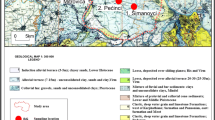Abstract
A soil geochemical survey was undertaken in the cultivated region of Agia in Thessaly area, Central Greece. The objectives of the study were to assess the levels of soil contamination in respect to average concentrations of toxic metals in the region, to determine the associations between the different toxic elements and their spatial distribution and to identify possible sources of contamination that can explain the spatial patterns of soil pollution in the area. One hundred seventy three soil samples were collected and analysed by ICP-AES after digestion with a mixture of HClO4–HNO3–H2O. The study focused on eleven elements (Cu, Pb, Zn, Ni, Co, Mn, As, V, Cr, Fe and Mg) and all of them except Pb have mean concentrations above the average global soil composition. The elements Ni, Cr, Mn and V show concentrations that according to G.L.C guidelines the Agia soils are classified as slightly contaminated to contaminated. Factor analysis explained 84.02% of the total variance of the data through four factors. Combined with spatial interpretation of its output, the method successfully grouped the elements according to their sources and provided evidence about their natural or anthropogenic origin.






Similar content being viewed by others
References
Alloway BJ, Ayres DC (1993) Chemical principles of environmental pollution. Blackie Academic and Professional, London
Appleton JD (1995) Potentially harmful elements from natural sources and mining areas: characteristics, extent and relevance to planning and development in Great Britain. British Geological Survey, Technical Report WP/95/3, Keyworth, Nottingham
Bieber A (1998) Aspects of contaminated sites and of the reuse of polluted soil in Germany. In: Guercia F, Mariotti C (eds) Risk assessment and risk management of contaminated sites in Europe. Proceeding of the international workshop, ANPA, Rome, pp 39-55
Connor JJ, Shackelette HT (1975) Background geochemistry of some soils, plants and vegetables in the conterminous United States. United States Geological Survey and Research Professional Papers 574-F, p 164
Davies BE (1997) Heavy metal contaminated soils in an old industrial area of Wales. Great Britain: source identification through statistical data interpretation. Water Air Soil Pollut 94:85–98
Harmon H (1976) Modern factor analysis, 3rd edn. University of Chicago Press, IL
IGME. PLATYCAMPOS SHEET (1981) Geological Map 1:50,000. Department of geological maps of IGME, Athens, Greece
IGME. AYIA-PANAYIA AYIAS SHEET (1984) Geological Map 1:50,000. Department of geological maps of IGME, Athens, Greece
Kabata Pendias A, Pendias H (1992) Trace elements in soils and plants. CRC Press, Boca Raton Florida, p 315
Kelepertsis A, Karamanou E, Polyzonis E (1982) Factor analysis in interpretation of geochemical data. An example from Laodikino Akropotamia-Kilkis area. Miner Wealth 18
Kelepertsis A, Reeves R, Baker A (1990) The use of the genus Alyssum as a safe geobotanical–biogeochemical indicator in geological mapping of Greek ultrabasic rocks. Prak Athens Acad 65:170–176
Kelepertsis A, Alexakis D, Kita I (2001) Environmental geochemistry of soils and waters of Susaki area, Korinthos, Greece. Environ Geochem Health 23:117–135
Mariotti C (1998) Legislative aspect and risk assessment for contaminated sites in Italy: the UNICHIM approach. In: Guercia F, Mariotti C (eds) Risk assessment and risk management of contaminated sites in Europe. Proceeding of the international workshop, ANPA, Rome, pp 69–80
Mattigot SV, Page AL (1983) Assessment of metal pollution in soils. In: Thorton (ed) Applied environmental geochemistry. Academic Press, London, Chapter 12, pp 355–395
Merian E (ed) (1991) Metals and their compounds in the environment: occurrence, analysis and biological relevance. VCH, Cambridge, p 1373
Migiros G (1983) Geological structure of the Lower Olymbous area, Thessaly, Greece. PhD Thesis, University of Patras, 204pp
Migiros G (1993) Mineral deposits of the Agia area. Institute of Geology and Mineral Exploration, Athens, Greece. Internal Report
Ramsey MH, Thompson M, Banerjee EK (1987) A realistic assessment of analytical data quality from inductively coupled plasma atomic emission spectrometry. Anal Proc 24:260–265
Thorton I, Abrahams P (1983) Soil ingestion—a major pathway of heavy metals into livestock grazing contaminated land. Sci Total Environ 28:282–294
Author information
Authors and Affiliations
Corresponding author
Rights and permissions
About this article
Cite this article
Skordas, K., Kelepertsis, A. Soil contamination by toxic metals in the cultivated region of Agia, Thessaly, Greece. Identification of sources of contamination. Environ Geol 48, 615–624 (2005). https://doi.org/10.1007/s00254-005-1319-x
Received:
Accepted:
Published:
Issue Date:
DOI: https://doi.org/10.1007/s00254-005-1319-x




